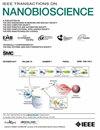COTiR: Molecular Communication Model for Synthetic Exosome-Based Tissue Regeneration
IF 3.7
4区 生物学
Q1 BIOCHEMICAL RESEARCH METHODS
引用次数: 0
Abstract
Mesenchymal stem cell (MSC)-derived exosomes are recognized as an unparalleled therapy for tissue damage rendered by COVID-19 infection and subsequent hyper-inflammatory immune response. However, the natural targeting mechanism of exosomes is challenging to detect the damaged tissue over long diffusion distances efficiently. The coordinated movement of exosomes is desired for successful identification of target sites. In this work, we propose a molecular communication model, CoTiR, with a bio-inspired directional migration strategy (DMS) for guided propagation of exosomes to target the damaged tissues. The model includes directional propagation, reception, and regeneration of tissue. The proposed model has the potential to be used in designing efficient communication systems in the nanodomain. We compare the proposed model to the basic random propagation model and show the efficacy of our model regarding the detection of multiple targets and the detection time required. Simulation results indicate that the proposed model requires a shorter period of time for a similar number of exosomes to detect the targets compared to the basic random propagation model. Furthermore, the results reveal a 99.96% decrease in the collagen concentration in the absence of inflammatory cytokine molecules compared to the collagen concentration in the presence of inflammatory cytokine molecules.COTiR:基于合成外泌体的组织再生分子交流模型。
间充质干细胞(MSC)衍生的外泌体被认为是治疗COVID-19感染和随后的高炎症免疫反应造成的组织损伤的一种无与伦比的疗法。然而,外泌体的天然靶向机制很难有效地检测到长距离扩散的受损组织。为了成功识别目标部位,我们需要外泌体的协调运动。在这项工作中,我们提出了一种分子通信模型 CoTiR,该模型具有生物启发的定向迁移策略(DMS),用于引导外泌体传播,以靶向受损组织。该模型包括定向传播、接收和组织再生。所提出的模型有望用于设计纳米领域的高效通信系统。我们将提出的模型与基本随机传播模型进行了比较,并展示了我们的模型在检测多个目标和所需检测时间方面的功效。仿真结果表明,与基本随机传播模型相比,提议的模型需要更短的时间来检测相似数量的外泌体目标。此外,结果显示,与存在炎性细胞因子分子时的胶原蛋白浓度相比,不存在炎性细胞因子分子时的胶原蛋白浓度降低了 99.96%。
本文章由计算机程序翻译,如有差异,请以英文原文为准。
求助全文
约1分钟内获得全文
求助全文
来源期刊

IEEE Transactions on NanoBioscience
工程技术-纳米科技
CiteScore
7.00
自引率
5.10%
发文量
197
审稿时长
>12 weeks
期刊介绍:
The IEEE Transactions on NanoBioscience reports on original, innovative and interdisciplinary work on all aspects of molecular systems, cellular systems, and tissues (including molecular electronics). Topics covered in the journal focus on a broad spectrum of aspects, both on foundations and on applications. Specifically, methods and techniques, experimental aspects, design and implementation, instrumentation and laboratory equipment, clinical aspects, hardware and software data acquisition and analysis and computer based modelling are covered (based on traditional or high performance computing - parallel computers or computer networks).
 求助内容:
求助内容: 应助结果提醒方式:
应助结果提醒方式:


